Abstract
The effects of wash-water temperature, cold-water or regular detergent, wash-cycle design, drying, and drying temperature on survival of four microorganisms on polyester-cotton sheeting were examined. Escherichia coli T3 bacteriophage survived washing at 24, 35, 46, and 57 C, but not at 68 C. Serratia marcescens survived only the lowest three wash temperatures. Levels of residual Staphylococcus aureus were diminished at the highest two wash temperatures, but survival was substantial even at 68 C. Counts of Bacillus stearothermophilus spores were not altered appreciably by wash temperature. Type of detergent had no practical effect on observed counts. The regular wash cycle was significantly more efficient in removal of microorganisms than the permanent-press cycle. Counts, especially of the bacteriophage and the gramnegative bacterium, were decreased by drying; after drying, the effects of wash-water temperature on S. aureus and B. stearothermophilus were not significantly different. Microorganisms were transferred from inoculated to sterilized sheeting during laundering. The public health significance of these observations is discussed.
Full text
PDF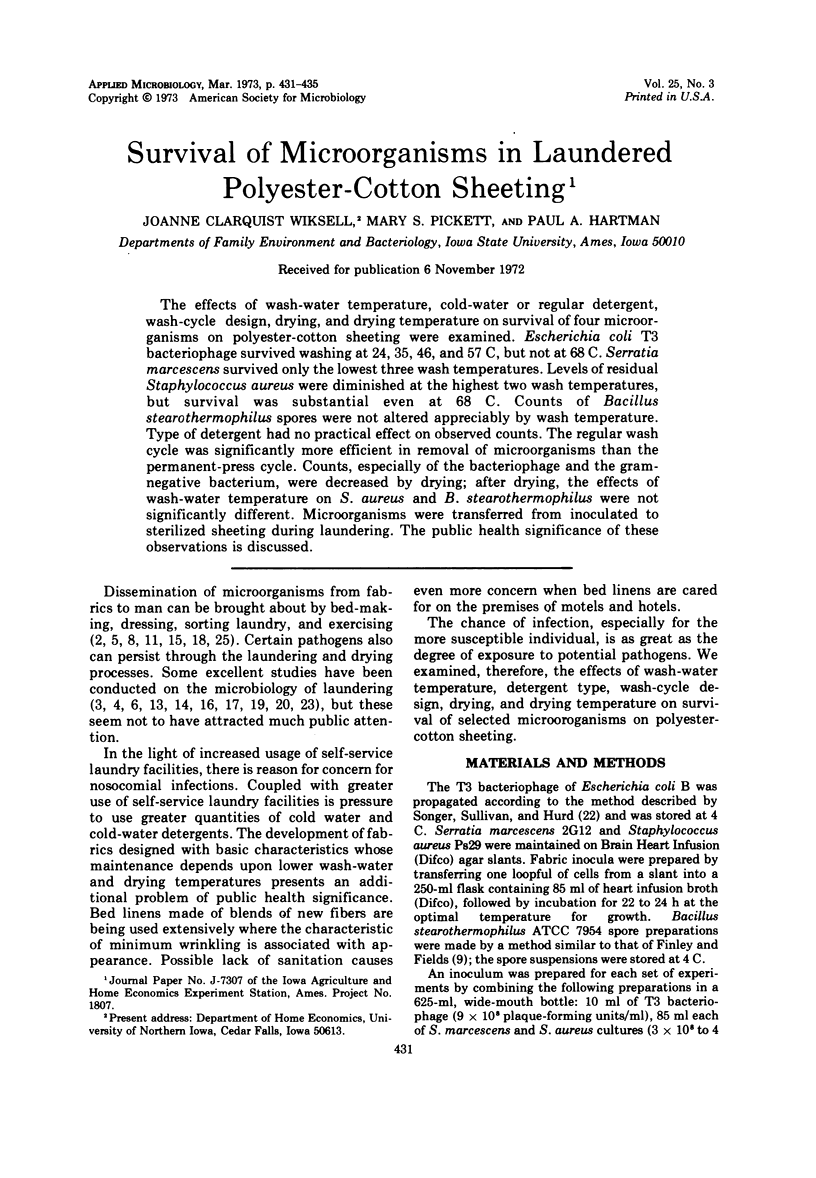
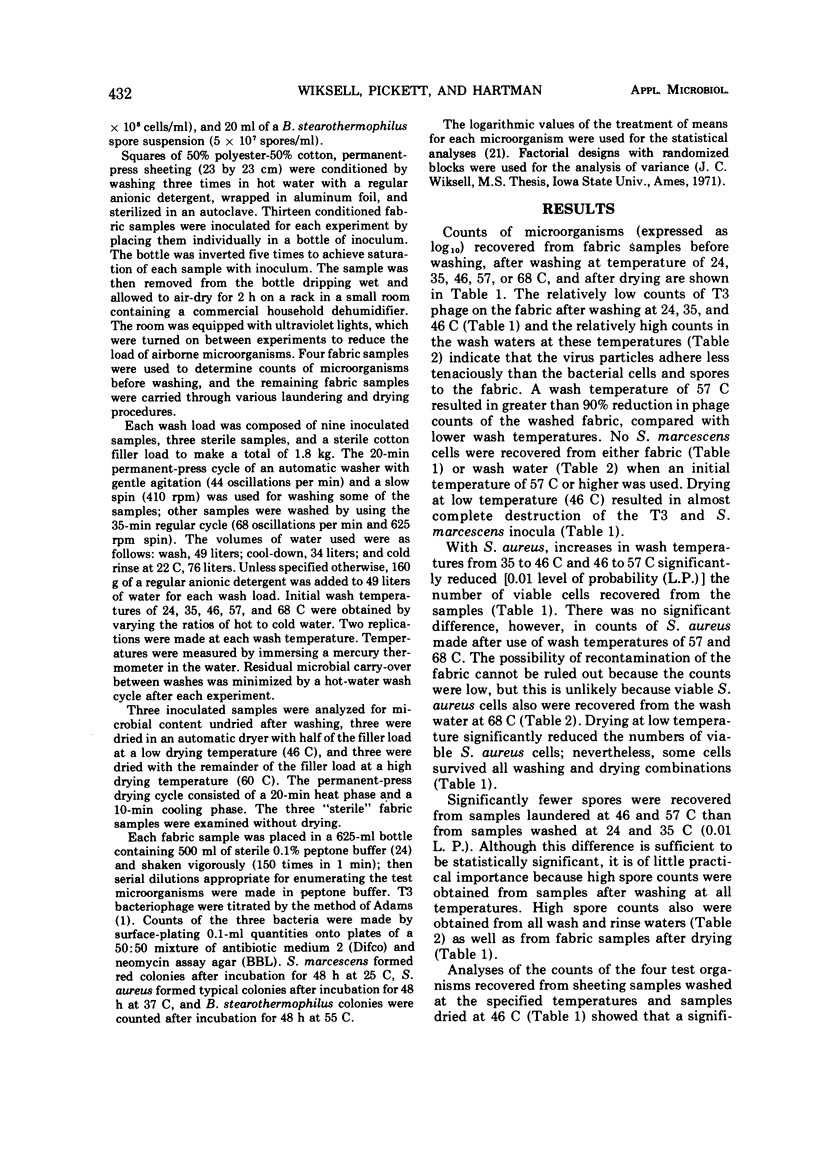
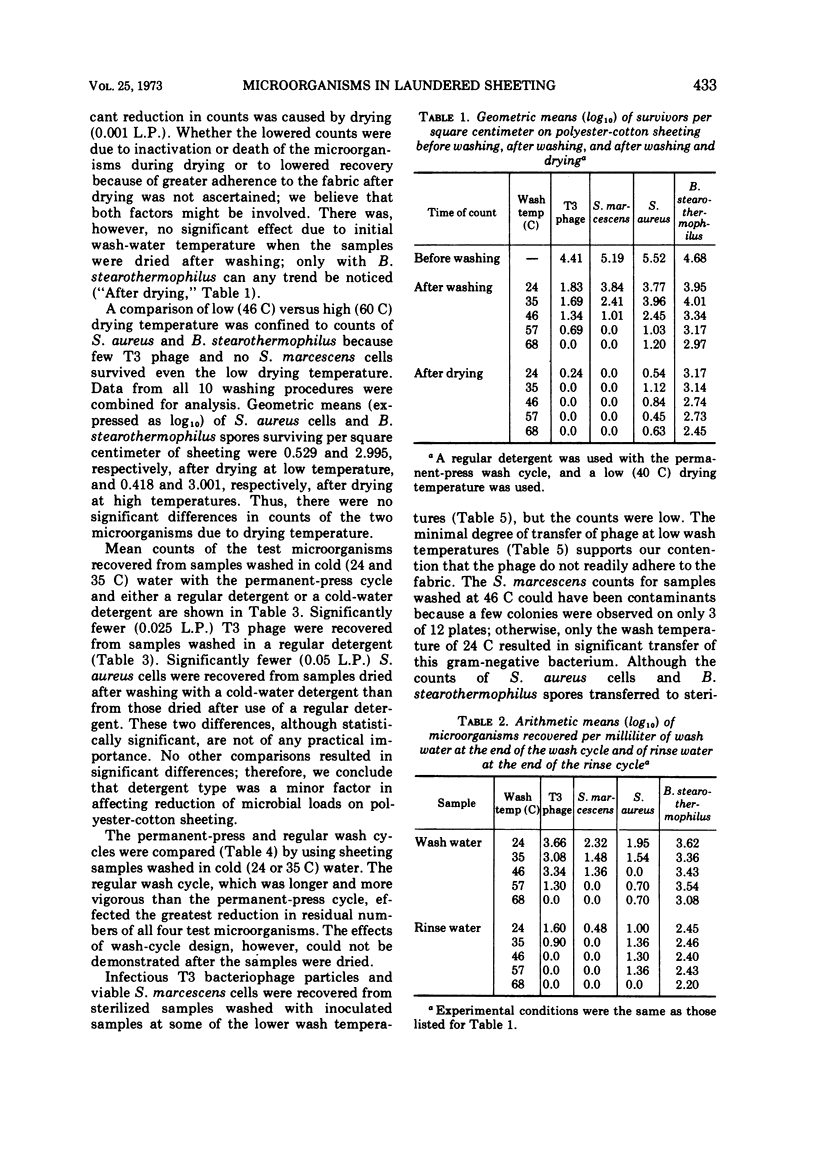
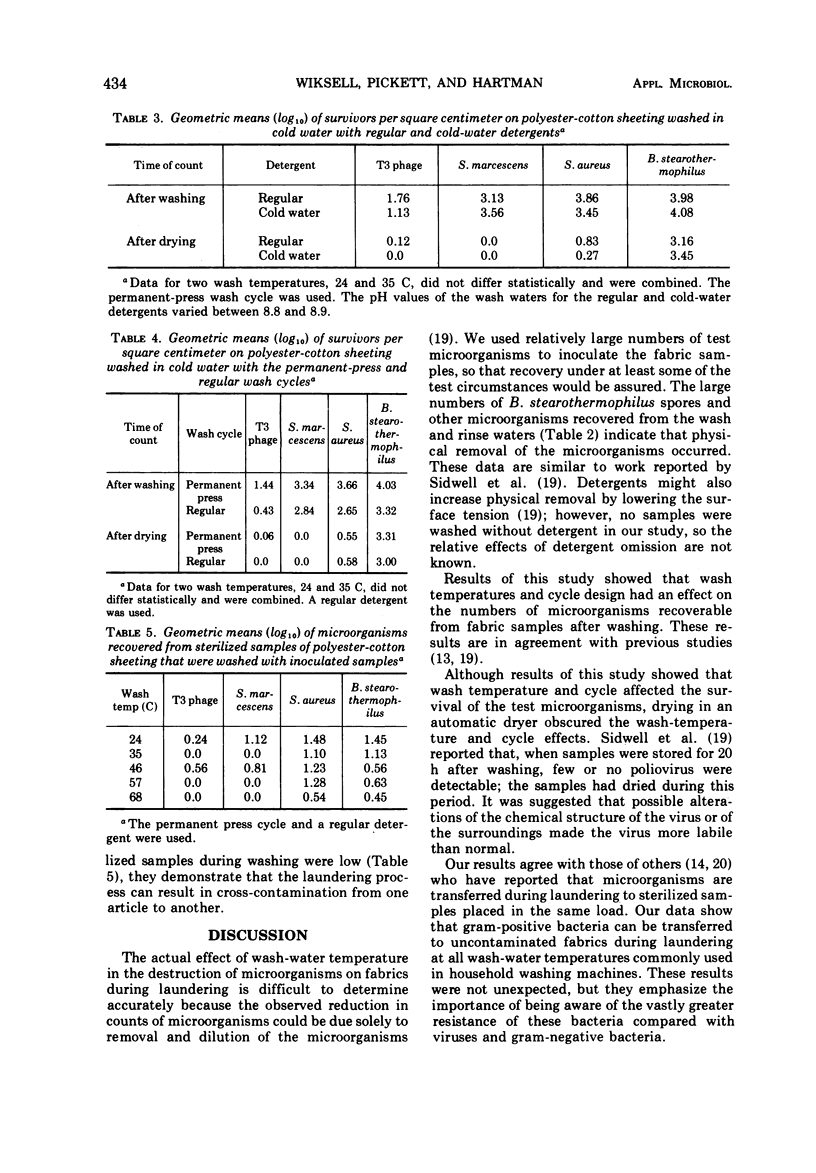
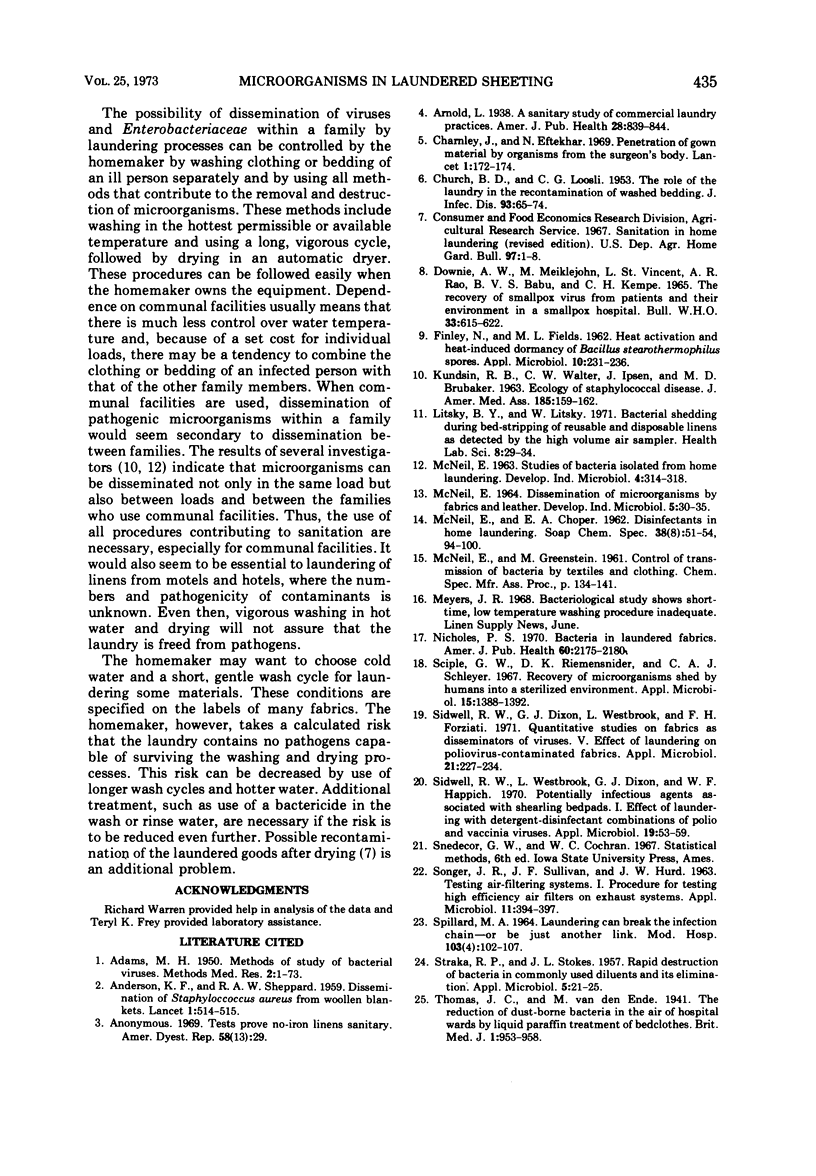
Selected References
These references are in PubMed. This may not be the complete list of references from this article.
- ANDERSON K. F., SHEPPARD R. A. Dissemination of Staphylococcus aureus from woollen blankets. Lancet. 1959 Mar 7;1(7071):514–515. doi: 10.1016/s0140-6736(59)91040-2. [DOI] [PubMed] [Google Scholar]
- Arnold L. A Sanitary Study of Commercial Laundry Practices. Am J Public Health Nations Health. 1938 Jul;28(7):839–844. doi: 10.2105/ajph.28.7.839. [DOI] [PMC free article] [PubMed] [Google Scholar]
- CHURCH B. D., LOOSLI C. G. The role of the laundry in the recontamination of washed bedding. J Infect Dis. 1953 Jul-Aug;93(1):65–74. doi: 10.1093/infdis/93.1.65. [DOI] [PubMed] [Google Scholar]
- Charnley J., Eftekhar N. Penetration of gown material by organisms from the surgeon's body. Lancet. 1969 Jan 25;1(7587):172–173. doi: 10.1016/s0140-6736(69)91188-x. [DOI] [PubMed] [Google Scholar]
- Downie A. W., Meiklejohn M., St Vincent L., Rao A. R., Sundara Babu B. V., Kempe C. H. The recovery of smallpox virus from patients and their environment in a smallpox hospital. Bull World Health Organ. 1965;33(5):615–622. [PMC free article] [PubMed] [Google Scholar]
- FINLEY N., FIELDS M. L. Heat activation and heat-induced dormancy of Bacillus stearothermophilus spores. Appl Microbiol. 1962 May;10:231–236. doi: 10.1128/am.10.3.231-236.1962. [DOI] [PMC free article] [PubMed] [Google Scholar]
- KUNDSIN R. B., WALTER C. W., IPSEN J., BRUBAKER M. D. ECOLOGY OF STAPHYLOCOCCAL DISEASE. STUDY OF A COMMUNITY OF MARRIED GRADUATE STUDENTS. JAMA. 1963 Jul 20;185:159–162. doi: 10.1001/jama.1963.03060030017017. [DOI] [PubMed] [Google Scholar]
- Litsky B. Y., Litsky W. Bacterial shedding during bed-stripping of reusable and disposable linens as detected by the high volume air sampler. Health Lab Sci. 1971 Jan;8(1):29–34. [PubMed] [Google Scholar]
- Nicholes P. S. Bacteria in laundered fabrics. Am J Public Health Nations Health. 1970 Nov;60(11):2175–2180. doi: 10.2105/ajph.60.11.2175. [DOI] [PMC free article] [PubMed] [Google Scholar]
- SONGER J. R., SULLIVAN J. F., HURD J. W. TESTING AIR-FILTERING SYSTEMS. I. PROCEDURE FOR TESTING HIGH-EFFICIENCY AIR FILTERS ON EXHAUST SYSTEMS. Appl Microbiol. 1963 Sep;11:394–397. doi: 10.1128/am.11.5.394-397.1963. [DOI] [PMC free article] [PubMed] [Google Scholar]
- SPILLARD M. A. LAUNDERING CAN BREAK THE INFECTION CHAIN. Mod Hosp. 1964 Oct;103:102–107. [PubMed] [Google Scholar]
- STRAKA R. P., STOKES J. L. Rapid destruction of bacteria in commonly used diluents and its elimination. Appl Microbiol. 1957 Jan;5(1):21–25. doi: 10.1128/am.5.1.21-25.1957. [DOI] [PMC free article] [PubMed] [Google Scholar]
- Sciple G. W., Riemensnider D. K., Schleyer C. A. Recovery of microorganisms shed by humans into a sterilized environment. Appl Microbiol. 1967 Nov;15(6):1388–1392. doi: 10.1128/am.15.6.1388-1392.1967. [DOI] [PMC free article] [PubMed] [Google Scholar]
- Sidwell R. W., Dixon G. J., Westbrook L., Forziati F. H. Quantitative studies on fabrics as disseminators of viruses. V. Effect of laundering on poliovirus-contaminated fabrics. Appl Microbiol. 1971 Feb;21(2):227–234. doi: 10.1128/am.21.2.227-234.1971. [DOI] [PMC free article] [PubMed] [Google Scholar]
- Sidwell R. W., Westbrook L., Dixon G. J., Happich W. F. Potentially infectious agents associated with shearling bedpads. I. Effect of laundering with detergent-disinfectant combinations on polio and vaccinia viruses. Appl Microbiol. 1970 Jan;19(1):53–59. doi: 10.1128/am.19.1.53-59.1970. [DOI] [PMC free article] [PubMed] [Google Scholar]


